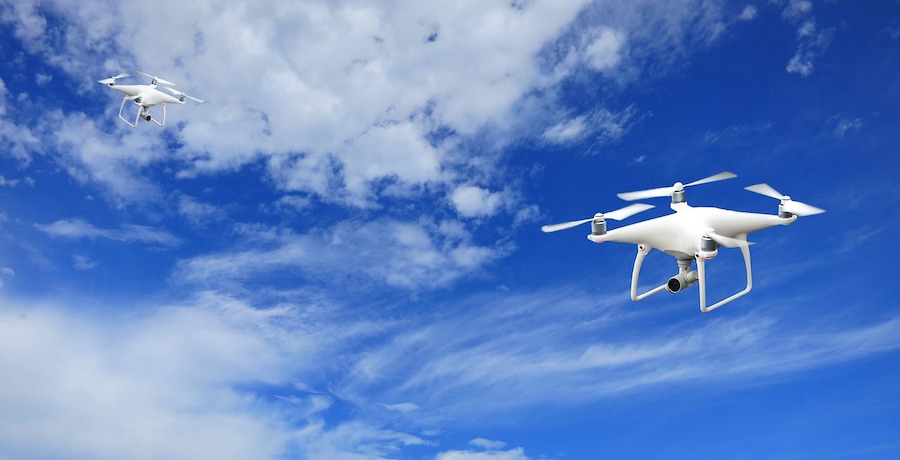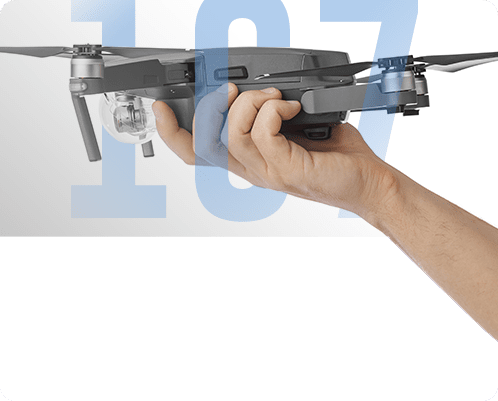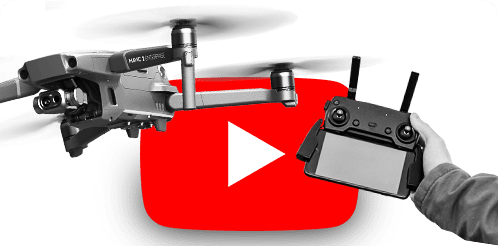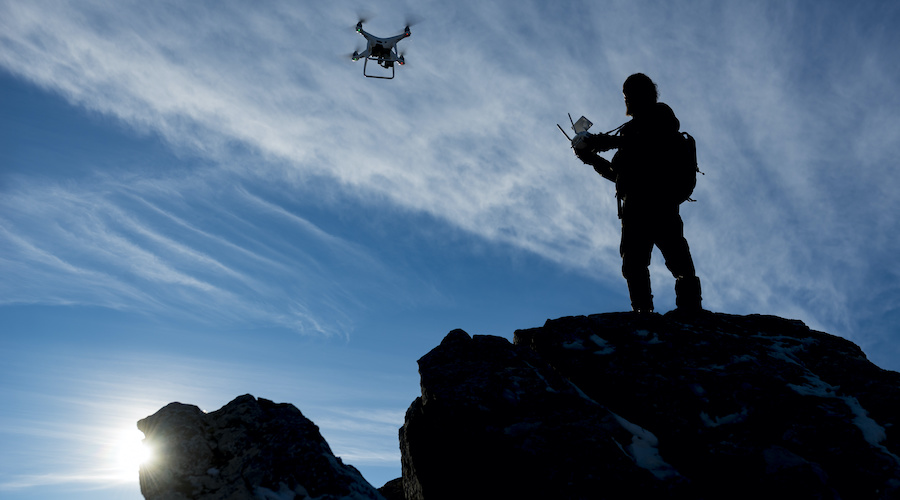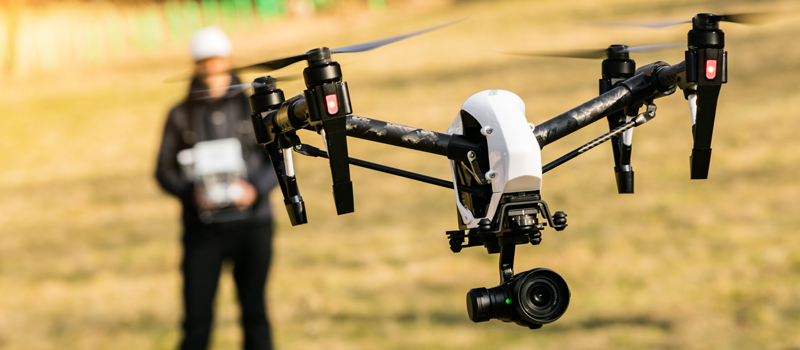-
What do the Part 107 rules say?
-
What’s the basis for the 400-foot limit?
-
Flying over structures in controlled airspace
-
From what reference point should 400 feet be measured from?
-
Is it physically possible for drones to fly above 400 feet?
- Drone News Update
-
Can I get a waiver for drone flight above 400 feet AGL?
-
What about hobbyists?
-
Final thoughts
Note: This article does not provide legal advice. Please retain an attorney to verify this information.
One of the most established rules of drone flight, and one that applies to both recreational and professional drone pilots, is that they can only fly at a maximum altitude of 400 feet. This figure has been hammered so often into the minds of drone pilots that it has become an indelible part of the way things are done.
The rule has become so ubiquitous that rarely does anyone stop to question its details. What do the rules say, specifically? Is there any way that drone pilots can still fly above 400 feet legally? What’s the basis for the 400-foot altitude limit anyway?
What do the Part 107 rules say?
For the best reference to what the law says specifically, we’ll go the definitive aeronautical laws that were created for drone flight – the Part 107 rules. Although 14 CFR Part 107 only applies for drone pilots, it is also the strictest standards created for drone flight. To make sure that we are operating within legal boundaries, it would be safer to set the Part 107 rules as the standard.
The relevant rules under Part 107 are summarized within Section 107.51. This section is entitled “Operating limitations for small unmanned aircraft” and contains a set of limits associated with speed, altitude, and visibility. Pertaining to altitude, item B of the Section states that:
“The altitude of the small unmanned aircraft cannot be higher than 400 feet above ground level unless the small unmanned aircraft is (1) flown within a 400-foot radius of a structure, and (2) does not fly higher than 400 feet above the structure’s immediate uppermost limit.”
The way that the rule is stated immediately offers an exception: that it’s possible to fly above 400 feet if you are flying in the vicinity of a (presumably) large structure. There’s still a bit of ambiguity, though, as Part 107 does not provide a definition of a ‘structure’ or precisely from what reference point the 400-foot limit should be measured from.
To be able to dissect the specifics of the rule, it would be a good idea to understand the rationale behind it. What exactly is the FAA trying to avoid when it imposed the 400-foot limit?
What’s the basis for the 400-foot limit?
The basis for the 400-foot limit is easy to explain. Most manned aircraft activities occur at 500 feet or above, except within the controlled airspace near airports. The original notice of proposed rulemaking (NPRM) for Part 107 set the maximum altitude for drones at 500 feet, but the final published rule reduced this limit to 400 feet. The 100-foot buffer was established to avoid any close encounters between drones and manned aircraft. This was a decision that most of the drone community agreed with.
To further emphasize the importance of this altitude limit, statistics showed that there were 921 recorded incidents of close encounters between drones and manned aircraft before the Part 107 rules were implemented. Of these cases, there were 28 instances where the manned aircraft had to execute evasive maneuvers to avoid getting into proximity danger with the drones. Drone crashes are one thing, but when they endanger manned aircraft, they run the risk of causing much more severe damage and loss of life.
Flying over structures in controlled airspace
A common misconception about the regulation in 107.51 is that you can apply it in any airspace. This is actually not the case. Case in point, when you receive a LAANC authorization, the following statement is accompanied with your authorization:
Altitude limits are absolute values above ground level which shall not be added to the height of any structures.
This statement essentially prevents you from flying any higher than the altitude you were approved for, regardless of the presence of structures. This means that when in Class B, C, D, or E2, you cannot fly 400 feet over structures.
When flying 400 feet over an obstacle in uncontrolled airspace, you also have to stay out of controlled airspace that requires authorization, such as class B, C, or D.
For example, if you are trying to inspect a structure that is 1500 feet tall, but a layer of Class B airspace starts at 1200 feet AGL, you can only fly near this structure up to to 1199 feet AGL.
From what reference point should 400 feet be measured from?
According to Section 107.51, drones can fly above 400 feet if they are flying within the vicinity of a structure. The working of this exception is that manned aircraft will also adjust their cruising altitude when they pass over any large structures. For instance, an airplane cruising at 500 feet will gain altitude as it passes a large building, communication tower, or a mountain.
What the rule implies is that the 400-foot limit is measured “above ground level.”. This is in contrast to measuring it from an absolute reference point, or from sea level.
The 400-foot limit is measured above the surface. Any manned aircraft flying in the vicinity will similarly adjust their cruising altitudes, so there shouldn’t be any risk of close encounters as long you stay within the 400-foot limit.
Is it physically possible for drones to fly above 400 feet?
In terms of physical capability, there’s nothing that can stop drones from flying above 400 feet. Although air pressure decreases with an increase in altitude, the reduction in lift only makes it impossible for drones to fly at an altitude of around 13,000 feet. At this altitude, most drones cannot generate enough lift to allow their own weight to lift off the ground. However, it’s going to be very hard to accidentally find yourself at this altitude – you’ll have to hike to some of the highest mountain peaks in the world.
Technology-wise, most modern drones come with built-in altimeters that are programmed to detect if you are flying near or above the 400-foot limit. These altimeters work by measuring the surrounding air pressure and comparing it to air pressure at sea level, which the drone measures during calibration.
The good thing about drone altimeters is that they are programmed to set the “zero” altitude at the point of take-off. This means that it’s still possible to fly up 400 feet from a high-altitude takeoff point before your drone prevents any further altitude gain. Be careful though, 400 feet above the ground is what matters here, so be aware of your surrounding terrain.
This also means that it’s possible to get a negative altitude reading if you decide to fly your drone down from your take-off point. This has no effect on the performance of your drone. Just make sure that you don’t land your drone at a lower altitude, as it might restart the altitude to zero at the new take-off point. This could make it difficult for you to retrieve your drone.
Can I get a waiver for drone flight above 400 feet AGL?
The 400-foot altitude limit is a built-in in the firmware of most drones sold today. However, there are a few enterprise-level drones that allow the firmware to be customized to remove this restriction. It’s rare for drone operations to require the lifting of such restrictions, and it is only for commercial applications does the FAA provides some leeway for it.
The FAA allows the 400-foot altitude limit to be waiver upon request by Part 107-licensed drone pilots. Waivers are requested through the FAA DroneZone website through a process that requires the drone operator to describe the proposed operations in heavy detail. All the risks associated with the operations need to be identified, and mitigating measures have to be included in the proposal. This can be a long and tedious process for which the FAA recommends a 90-day lead time.
There have been a few successful waiver applications for flight above 400 feet AGL. From the waiver documents, we can see that the FAA requires very strict safety requirements from these operators, including records for pre-inspection checks and detailed flight logs. Moreover, the FAA requires the drone operator to issue a notice to airmen (NOTAM) two days prior to the activity. This NOTAM will then be broadcasted by the FAA to all airmen in the vicinity so that they may adjust their altitudes according to the parameters of the drone operations.
What about hobbyists?
Hobbyists do not follow Part 107 regulation. As a result, hobbyists cannot fly 400 feet over a structure, whether in controlled or uncontrolled airspace. Hobbyists are limited to 400 feet AGL at all time in uncontrolled airspace, and whatever the altitude limit is when flying in controlled airspace (as specified by the grid).
There is currently no waiver process available for hobbyists to fly above 400 feet AGL in uncontrolled airspace, and there is no waiver process to fly higher than the published grid numbers in controlled airspace.
Final thoughts
The 400-foot rule for drones may seem like an absolute limit, but it’s actually one of the most flexible of the drone restrictions. Not only can drones take off from higher altitudes if you are flying in the vicinity of a large structure, but drone pilots can also request for a waiver to fly above 400 feet AGL.
No matter the case, don’t forget that the ultimate goal is to maintain the safety of national airspace. Even if you are flying within 400 feet, you must still give way to manned aircraft.
